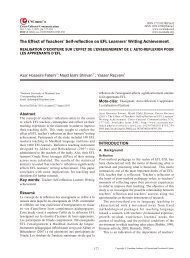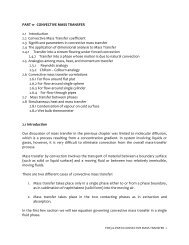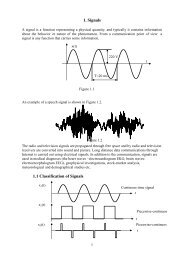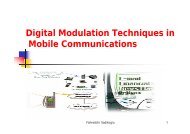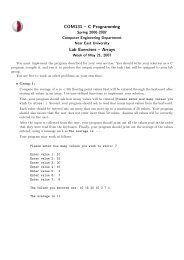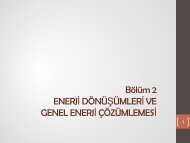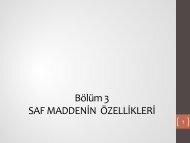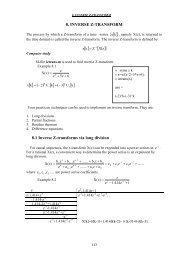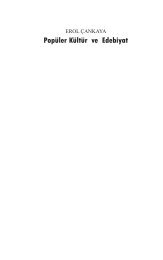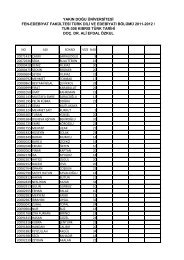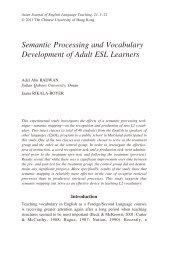(2010). The analysis of classroom talk: Methods and methodologies ...
(2010). The analysis of classroom talk: Methods and methodologies ...
(2010). The analysis of classroom talk: Methods and methodologies ...
You also want an ePaper? Increase the reach of your titles
YUMPU automatically turns print PDFs into web optimized ePapers that Google loves.
<strong>The</strong>BritishBritish Journal <strong>of</strong> Educational Psychology (<strong>2010</strong>), 80, 1-14Psychological©20/0 <strong>The</strong> British Psycho/ogica/Society WSBSSm Societywww.bpsjournals.co.ukAnnual review<strong>The</strong> <strong>analysis</strong> <strong>of</strong> <strong>classroom</strong> <strong>talk</strong>: <strong>Methods</strong> <strong>and</strong><strong>methodologies</strong>Neil Mercer*Faculty <strong>of</strong> Education <strong>and</strong> Hughes Hall, University <strong>of</strong> Cambridge, UKThis article describes methods for analysing <strong>classroom</strong> <strong>talk</strong>, comparing their strengths<strong>and</strong> weaknesses. Both quantitative <strong>and</strong> qualitative methods are described <strong>and</strong> assessedfor their strengths <strong>and</strong> v^eaknesses, with a discussion <strong>of</strong> the mixed use <strong>of</strong> such methods.It is acknowledged that particular methods are <strong>of</strong>ten embedded in particular<strong>methodologies</strong>, which are based on specific theories <strong>of</strong> social action, researchparadigms, <strong>and</strong> disciplines; <strong>and</strong> so a comparison is made <strong>of</strong> two contemporary<strong>methodologies</strong>, linguistic ethnography, <strong>and</strong> sociocultural research. <strong>The</strong> articleconcludes with some comments on the current state <strong>of</strong> development <strong>of</strong> this field <strong>of</strong>research <strong>and</strong> on ways that it might usefully progress.In this paper, I will describe some methods for analysing the <strong>talk</strong> <strong>and</strong> interaction <strong>of</strong>teachers <strong>and</strong> students, discussing their various affordances <strong>and</strong> limitations. One obviousway that methods vary is whether they provide qualitative or quantitative results, <strong>and</strong> soI wül use that distinction as a major organizing principle. In educational researchgenerally, the selection <strong>of</strong> a method seems <strong>of</strong>ten to reflect researchers' attachmentto different epistemological theories, disciplinary traditions, <strong>and</strong> research paradigms.So in the study <strong>of</strong> <strong>classroom</strong> <strong>talk</strong>, different paradigms <strong>of</strong> enquiry, or <strong>methodologies</strong>,can be distinguished; <strong>and</strong> these embody certain tenets or principles about the nature <strong>of</strong>educational <strong>talk</strong> <strong>and</strong> how it can best be studied. For example, two influential approachesto the study <strong>of</strong> <strong>classroom</strong> <strong>talk</strong> in the UK are linguistic ethnography <strong>and</strong> socioculturalresearch. <strong>The</strong>y have arisen from different disciplinary traditions, <strong>and</strong> those traditionsnot only influence researchers' methodological choices, but also the framing <strong>of</strong> theirresearch questions <strong>and</strong> their conceptions <strong>of</strong> how educational research should relate topractice. Before describing particular methods, then, I will briefly describe these tworather different approaches.Linguistic ethnography has a heritage <strong>of</strong> social anthropology <strong>and</strong> descriptivelinguistics. Studies are typically observational, non-interventional, <strong>and</strong> qualitative.<strong>The</strong> essence <strong>of</strong> this approach is well explained in a paper by some leading exponents* Correspondence should be addressed to Pr<strong>of</strong>essor Neil Mercer, Faculty <strong>of</strong> Education, University <strong>of</strong> Cambridge, 184 HillsRoad, Can:)bridge CB2 8PQ, UK (e-mail: nmm3l@cam.ac.uk).DOI: 10.1348/000709909X479853
2 Ne/7 /VIercer(Rampton et al., 2004); Creese (2008) <strong>and</strong> Tusting <strong>and</strong> Maybin (2007) are also veryinformative. Illustrative examples <strong>of</strong> this kind <strong>of</strong> research are Lefstein (2008),Maybin (2006), <strong>and</strong> Rampton (2007). Researchers normally employ the ethnographic<strong>and</strong> sociolinguistic methods I describe later in this article, which involve the close <strong>and</strong>detailed examination <strong>of</strong> <strong>classroom</strong> <strong>talk</strong> in its social <strong>and</strong> cultural context. <strong>The</strong>y areunlikely to use any form <strong>of</strong> experimental method, or to use statistical <strong>analysis</strong>. Indeed,they are likely to feel quantitative, pre/post analyses <strong>of</strong> changes in <strong>talk</strong> or <strong>of</strong> learninggains are antithetical to a proper exploration <strong>and</strong> underst<strong>and</strong>ing <strong>of</strong> <strong>classroom</strong>communication. <strong>The</strong>y have addressed research questions such as the following:• How does <strong>classroom</strong> discourse enable, or inhibit, the expression <strong>of</strong> identities?• How are the languages/language varieties <strong>of</strong> different cultures recognized <strong>and</strong> usedin schools?• Is current educational policy sensitive to the linguistic <strong>and</strong> cultural reality <strong>of</strong>school life?Linguistic ethnographers commonly emphasize that language <strong>and</strong> social life are mutuallyshaping; that <strong>talk</strong> is always referential, interpersonal, emotive, <strong>and</strong> evaluative; thatsocialization is a never-ending process, mediated through <strong>talk</strong> <strong>and</strong> interaction; thatlanguage genres are important features <strong>of</strong> educational culture; <strong>and</strong> that children use <strong>talk</strong>,in <strong>classroom</strong>s as much as anywhere else, to negotiate <strong>and</strong> explore their identities. <strong>The</strong>yalso <strong>of</strong>ten argue that social situations are unique <strong>and</strong> so generalizations <strong>of</strong> the kindcommonly made by quantitative researchers are <strong>of</strong> dubious validity.Sociocultural researchers, on the other h<strong>and</strong>, are more likely to affiliate to researchtraditions in social <strong>and</strong> developmental psychology <strong>and</strong> pedagogical studies, with strongattachments to the work <strong>of</strong> Vygotsky (1978; see also Daniels, 2001; Wertsch, 1985).A rationale for using this theoretical frame for studying <strong>classroom</strong> <strong>talk</strong> is provided byAlex<strong>and</strong>er (2000) <strong>and</strong> Mercer <strong>and</strong> Littleton (2007). Illustrative examples <strong>of</strong> research areBlack (2007), Howe, McWilliam, <strong>and</strong> Cross (2005), Skidmore (2006), Smith, Hardman,<strong>and</strong> Mroz (2004), <strong>and</strong> the collection edited by Mercer <strong>and</strong> Hodgkinson (2008). Nuthall'sdistinctive work also has much in common, theoretically <strong>and</strong> methodologically, with thisline <strong>of</strong> enquiry (Nuthall, 1999, 2007; see also Collins & O'Toole, 2006). Socioculturalstudies may be observational, interventional, <strong>and</strong>/or quasi-experimental. Researchersquite <strong>of</strong>ten combine qualitative <strong>and</strong> quantitative methods (as described under 'Mixedmethods' later in the article). <strong>The</strong>y have addressed questions such as:• How does dialogue promote learning <strong>and</strong> the development <strong>of</strong> underst<strong>and</strong>ing?• What types <strong>of</strong> <strong>talk</strong> are associated with the best learning outcomes?• Does collaborative activity help children to leam, or assist their conceptualdevelopment?Sociocultural researchers commonly emphasize that language is a cultural <strong>and</strong>psychological tool which (in Vygotskian terms) links the intermental <strong>and</strong> intramental -so, for example, <strong>classroom</strong> dialogue could have an important influence on thedevelopment <strong>of</strong> children's reasoning. <strong>The</strong>y also typically emphasize that knowledge <strong>and</strong>underst<strong>and</strong>ing are jointly created, that <strong>talk</strong> allows reciprocity <strong>and</strong> mutuality to bedeveloped through the continuing negotiation <strong>of</strong> meaning, <strong>and</strong> that education dependsupon the creation <strong>and</strong> maintenance <strong>of</strong> intersubjectivity or 'common knowledge'. Animplication <strong>of</strong>ten drawn is that teachers need to guide <strong>and</strong> scaffold learning, balancing
<strong>The</strong> <strong>analysis</strong> <strong>of</strong> <strong>classroom</strong> <strong>talk</strong> 3the control <strong>of</strong> dialogue between teachers <strong>and</strong> students (Myhill, Jones, & Hopper, 2005).I would suggest that it is because <strong>of</strong> the directly applied' orientation <strong>of</strong> manysociocuitural researchers that they are positively inclined towards the use <strong>of</strong> pre/postinterventional designs, seeking to measure differential effects <strong>of</strong> <strong>talk</strong> on problemsolving, learning, <strong>and</strong> conceptual change.Having focused on the differences between these two <strong>methodologies</strong>, it is worthnoting that they also have some shared principles. Researchers in both groups are thuslikely to agree that <strong>classroom</strong> education cannot be understood without due attention tothe nature <strong>and</strong> functions <strong>of</strong> <strong>talk</strong> (<strong>and</strong> that means there must be a qualitative element tothe <strong>analysis</strong>); that cultural <strong>and</strong> local norms shape the processes <strong>of</strong> teaching <strong>and</strong> learning;<strong>and</strong> that in the <strong>classroom</strong>, meanings are continually renegotiated through <strong>talk</strong> <strong>and</strong>interaction over variable periods <strong>of</strong> time. <strong>The</strong> implication is that one-<strong>of</strong>f, 'snapshot'studies <strong>of</strong> <strong>classroom</strong> <strong>talk</strong> are unlikely to yield as valid results as those which involvecontinuous <strong>and</strong> repeated observations, such as over a series <strong>of</strong> lessons. Both groups <strong>of</strong>researchers are likely to be critical <strong>of</strong> forms <strong>of</strong> <strong>classroom</strong> research which do not appearto recognize the importance <strong>of</strong> these principles - for example, through the use <strong>of</strong>simplistic coding schemes which treat all similar-looking utterances as repeatedinstances <strong>of</strong> the same event (at least if used without the correctional influence <strong>of</strong> aproper qualitative <strong>analysis</strong>, as discussed in more detail in later sections). <strong>The</strong>y wouldprobably also agree that the careful observation <strong>of</strong> <strong>classroom</strong> life commonly revealsmuch <strong>of</strong> interest that will not normally have been apparent to the teachers involved.To some extent, then, it is difficult to completely separate methods from<strong>methodologies</strong>. Some researchers, indeed, would probably argue that we should not.Nevertheless, in the rest <strong>of</strong> this article, I will attempt to describe methods which are incommon use simply in terms <strong>of</strong> their procedures <strong>and</strong> functionalities.Quantitative methodsQuantitative methods are those which use coding schemes to reduce the data <strong>of</strong>transcribed <strong>talk</strong> to counts <strong>of</strong> a specified set <strong>of</strong> features. <strong>The</strong> most well-known is'systematic observation', but increasingly common is the use <strong>of</strong> computer-based text<strong>analysis</strong> to measure relative frequencies <strong>of</strong> occurrence <strong>of</strong> particular words or patterns <strong>of</strong>language use.Systematic observationA well-established type <strong>of</strong> research on <strong>classroom</strong> interaction is known as 'systematicobservation'. It essentially involves allocating observed <strong>talk</strong> (<strong>and</strong> sometimes non-verbalactivity such as gesture) to a set <strong>of</strong> previously specified categories. <strong>The</strong> aim is usually toprovide quantitative results which can be subjected to statistical <strong>analysis</strong>. For example, theobserver may record the relative number <strong>of</strong> '<strong>talk</strong> turns' taken by teachers <strong>and</strong> students, ormeasure the extent to which they produce types <strong>of</strong> utterance as defined by theresearcher's categories (such as particular t>pes <strong>of</strong> questions used by teachers). <strong>The</strong> basicprocedure for setting up systematic observation is that researchers use their researchquestions <strong>and</strong> initial observations <strong>of</strong> <strong>classroom</strong> life to construct a set <strong>of</strong> categories intowhich all relevant <strong>talk</strong> (<strong>and</strong> any other communicative activity) can be classified. Observersare then trained to identify <strong>talk</strong> corresponding to each category, so that they can sit in<strong>classroom</strong>s or work from video-recordings <strong>and</strong> assign what they see <strong>and</strong> hear to the
4 Neil Mercercategories. Researchers may develop their own categorizing system, or they may take one'<strong>of</strong>f the shelf. An example is Underwood <strong>and</strong> Underwood (1999) who used Bales' (1950)interaction <strong>analysis</strong> schedule to analyse the dialogue between children as they negotiatedtheir way through a computer task. Teasley's (1995) work <strong>of</strong>fers an interesting example<strong>of</strong> the use <strong>of</strong> this type <strong>of</strong> method applied to the study <strong>of</strong> collaborative learning. In herstudy, the <strong>talk</strong> <strong>of</strong> children working in pairs on a problem-solving task was recorded<strong>and</strong> transcribed <strong>and</strong> each utterance attributed to 1 <strong>of</strong> 14 mutually exclusive categories.<strong>The</strong>se categories included such functions as 'prediction' <strong>and</strong> 'hypothesis'. Transcriptswere coded independently by two coders <strong>and</strong> the level <strong>of</strong> agreement measured to ensurereliability. A count <strong>of</strong> categories <strong>of</strong> <strong>talk</strong> in different groups was correlated w^ith outcomemeasures on the problem-solving activity in order to draw conclusions about thekinds <strong>of</strong> utterances which promote effective collaborative learning.Many experimental studies <strong>of</strong> collaborative interactions use statistical techniques toascertain whether there is any evidence <strong>of</strong> an association between the relativeoccurrence <strong>of</strong> particular features <strong>of</strong> <strong>classroom</strong> <strong>talk</strong> <strong>and</strong> students' success on task orlearning gain. For example, correlation techniques were used by Barbieri <strong>and</strong> Light(1992) <strong>and</strong> Howe <strong>and</strong> Tolmie (1999) to determine whether there was any evidence <strong>of</strong>an association between particular features <strong>of</strong> learners' <strong>talk</strong> while working together oncomputer-based tasks <strong>and</strong> their success on task <strong>and</strong> learning gain. Similarly, regressionanalyses have enabled researchers such as Underwood <strong>and</strong> Underwood (1999) todetermine which, if any, facets <strong>of</strong> the paired or group interaction were successfulpredictors <strong>of</strong> on-task performance.As well as allowing an examination <strong>of</strong> any associations between aspects <strong>of</strong>collaborative activity <strong>and</strong> measures <strong>of</strong> outcome, the use <strong>of</strong> coding schemes for analysing<strong>talk</strong> also affords other distinct advantages. A lot <strong>of</strong> data can be processed fairly quickly.This allows researchers to survey life in a large sample <strong>of</strong> <strong>classroom</strong>s without analysingit all in detail, <strong>and</strong> to move fairly quickly <strong>and</strong> easily from observations to <strong>analysis</strong>.Systematic observation has undoubtedly provided interesting <strong>and</strong> useful findingsregarding the nature <strong>of</strong> interactions amongst children working in pairs or groups(e.g. Bennett & Cass, 1989).However, it is also important to recognize that methods which use only coded <strong>talk</strong>data have some inherent limitations. <strong>The</strong> most serious are the problems <strong>of</strong> dealing withambiguity <strong>of</strong> meanings, the temporal development <strong>of</strong> meanings, <strong>and</strong> the fact thatutterances with the same surface form can have quite different functions. Codingschemes normally require observers to put together all observed utterances which sharethe same surface features. So, for example, if a teacher asks a class the 'closed' question'What is the capital <strong>of</strong> Peru?', it might seem to be unproblematic in its meaning <strong>and</strong>function, <strong>and</strong> so easy to code. But if a teacher asked that question before beginning a unit<strong>of</strong> work on Latin America, it could be being used to assess what relevant initial knowledgestudents have brought to this topic. If, on the other h<strong>and</strong>, it was asked at the end <strong>of</strong> theunit, it would probably have the very different ftmction <strong>of</strong> assessing w^hat students hadlearned from recent lessons. And yet again, the same question could be asked simply torouse a dozing pupil, without any particular expectation by the teacher that the responsewould demonstrate learning. Although coding schemes could, in principle, be refined toh<strong>and</strong>le such contextual variations, they rarely have been. <strong>The</strong>re are also difficulties indetermining the appropriate size <strong>of</strong> the unit <strong>of</strong> <strong>analysis</strong> to be coded - especially as thephenomenon under study involves a continual, evolutionary process <strong>of</strong> negotiation <strong>and</strong>re-negotiation <strong>of</strong> meaning between participants. For example, is the most meaningftilunit a question or question-<strong>and</strong>-answ^er? Crook (1994) highlights a further difficulty.
<strong>The</strong> <strong>analysis</strong> <strong>of</strong> <strong>classroom</strong> <strong>talk</strong> 5pointing out that a collaboration could be rich in instances <strong>of</strong> supposedly "productive"<strong>talk</strong>, in the sense that there is evidence <strong>of</strong> conflict, predicting, questioning, <strong>and</strong> so on <strong>and</strong>yet not lead to any worthwhile outcome. A simple count <strong>of</strong> such coded language featureswould not capture the extent to which <strong>talk</strong> is mobilized tow^ards a particular goal or thecreation <strong>of</strong> shared knowledge. Used in isolation, it would effectively reducecollaborations to atemporal 'inventories <strong>of</strong> utterances' (Crook, 1994, p. 150).Studying <strong>and</strong> underst<strong>and</strong>ing the temporal dimensions <strong>of</strong> collaborative activityamongst students represents a considerable theoretical <strong>and</strong> practical challenge, <strong>and</strong> <strong>of</strong>course no method is perfect. But categorical coding schemes are generallyinappropriate tools to use without the complementary use <strong>of</strong> a qualitative <strong>analysis</strong>, ifthere is an interest in studying the processes by which teachers <strong>and</strong> students buildshared underst<strong>and</strong>ings. In order to gain a fuller underst<strong>and</strong>ing <strong>of</strong> the processes <strong>of</strong>collaborative work, researchers need methods which recognize that collaborativeexperiences are typically more than just brief, time-limited, localized sessions <strong>of</strong> jointactivity. When researchers observe a class or group <strong>of</strong> students working together, theinteraction observed is located within a particular historical, institutional, <strong>and</strong> culturalcontext. Students <strong>and</strong> teachers have relationships with histories, which shape the fluidprocess <strong>of</strong> <strong>classroom</strong> interaction. As Crook (1999) also comments, any productivity <strong>of</strong>interaction observed within a particular session may arise from circumstances that havepreviously been established. This point is echoed by Light <strong>and</strong> Light (1999) <strong>and</strong> Scott(2007) who note that interactions in any one observed session are likely to havedeterminants in the histories <strong>of</strong> individuals, groups, <strong>and</strong> institutions.Computer-based text <strong>analysis</strong>Research in linguistics, in recent decades, has been revolutionized by the development<strong>of</strong> computer facilities for analysing large databases <strong>of</strong> written or spoken (transcribed)language. S<strong>of</strong>tware packages known as 'concordancers' enable any text file to bescanned easily for all instances <strong>of</strong> particular target words. (Commonly used examples areMonoconc, Wordsmith, <strong>and</strong> Cone 1.71. Recent versions <strong>of</strong> qualitative data <strong>analysis</strong>packages such as NVivo <strong>of</strong>fer some similar facilities.) Not only can their frequency <strong>of</strong>occurrence to be measured, but the <strong>analysis</strong> can also indicate which words tend tooccur together, <strong>and</strong> so help reveal the way words gather meanings by 'the companythat they keep'. <strong>The</strong> results <strong>of</strong> such searches can be presented as tabular concordances.One practical application <strong>of</strong> this method (outside educational research) has been incompiling dictionaries. Lexicographers now can base their definitions on an <strong>analysis</strong> <strong>of</strong>how words are actually used in a large databank (or 'corpus') <strong>of</strong> naturally occurringwritten <strong>and</strong>/or spoken language. Concordances can reveal some <strong>of</strong> the more subtlemeanings that words have gathered in use, meanings which are not captured by literaldefinitions. <strong>The</strong>se methods have more recently been taken up by <strong>classroom</strong> researchers.Once recorded <strong>talk</strong> has been transcribed into a word file, a concordancer allows aresearcher to move almost instantly between occurrences <strong>of</strong> particular words <strong>and</strong> thewhole transcription. This enables particular words <strong>of</strong> special interest to be 'hunted' inthe data, <strong>and</strong> their relative incidence <strong>and</strong> form <strong>of</strong> use in particular contexts to becompared. <strong>The</strong> basic data for this kind <strong>of</strong> <strong>analysis</strong>, throughout, remains the wholetranscription. By integrating this method with other methods, the <strong>analysis</strong> can be bothqualitative (targeting particular interactions or extended episodes) <strong>and</strong> quantitative(comparing the relative incidence <strong>of</strong> 'key w^ords', or <strong>of</strong> types <strong>of</strong> interaction as might asystematic observer). Initial exploratory work on particular short texts (or text extracts)
6 Neil Mercercan be used to generate hypotheses, which can then be tested systematically on a largetext or series <strong>of</strong> related texts. For example, a researcher may want to see if a technicalterm introduced by a teacher is taken up by students later in a lesson, or in theirgroup-based activity. By locating all instances <strong>of</strong> the term in the transcription flle, theways it is used by teachers <strong>and</strong> students can then be considered (see, for example.Mercer, 2000; Monaghan, 1999; Wegerif & Mercer, 1997).In summary, then, the strengths <strong>and</strong> weaknesses <strong>of</strong> quantitative methods areas follows:Strengths• An efficient way <strong>of</strong> h<strong>and</strong>ling a lot <strong>of</strong> data; a researcher can survey a lot <strong>of</strong> <strong>classroom</strong>language relatively quickly <strong>and</strong> analyse a representative sample <strong>of</strong> events;• enable numerical comparisons to be made across <strong>and</strong> within data samples, whichcan then be subjected to a statistical <strong>analysis</strong>.Weaknesses• Actual <strong>talk</strong>, as data, may be lost early in the <strong>analysis</strong>. A researcher works only withpredeflned categories, <strong>and</strong> so new insights which might be gained from repeatedconsiderations <strong>of</strong> the original data will be missed;• the use <strong>of</strong> pre-determined categories or other target items can limit analysts'sensitivity to what actually happens; <strong>and</strong>• coding which depends on the decontextualized identification <strong>of</strong> language featurescannot h<strong>and</strong>le the ways that the meaning <strong>of</strong> any utterance will depend on its historywithin the observed dialogue <strong>and</strong> perhaps in previous encounters betweenparticipants.Qualitative methods<strong>The</strong>se are methods which aim to reveal the nature, patterns, <strong>and</strong> quality <strong>of</strong> spokeninteractions. <strong>The</strong>y include ethnographic <strong>and</strong> sociolinguistic methods, <strong>and</strong> the methodknown as 'conversation <strong>analysis</strong>'. In practice, the first two <strong>of</strong>ten appear to be combined.<strong>The</strong> third tends to be kept distinct.Ethnographic <strong>analysis</strong>Ethnographic methods are an adaptation <strong>of</strong> methods developed by socialanthropologists <strong>and</strong> sociologists in non-educational fields (see e.g. Hammersley, 1982;Woods, 1983, for accounts <strong>of</strong> this). Ethnographic <strong>analysis</strong> aims for a dch, detaileddescription <strong>of</strong> observed events, through the researchers' continuous <strong>and</strong> closeinvolvement in the social environment they are studying. A classic example is Heath's(1983) study <strong>of</strong> children's language <strong>and</strong> literacy in <strong>and</strong> out <strong>of</strong> school in the southernUSA. Compared with the use <strong>of</strong> a quantitative method Uke systematic observation, thisinevitably limits the sheer amount <strong>of</strong> <strong>classroom</strong> interaction which can be analysed; <strong>and</strong>in any case, the aim is for depth <strong>of</strong> <strong>analysis</strong> rather than a more superficial <strong>analysis</strong> <strong>of</strong> alarge data set. It is therefore typical for studies which use ethnographic methods to studylife in just a few <strong>classroom</strong>s. For example, Maybin (2006) used radio microphones tocapture all the <strong>talk</strong> <strong>of</strong> a set <strong>of</strong> primary schoolchildren during their schooldays, both inlessons <strong>and</strong> in break periods, over several months. This data enabled her to show howchildren took up <strong>and</strong> developed certain ideas, themes, <strong>and</strong> ways <strong>of</strong> accounting forexperience together as they interacted, <strong>and</strong> to discern the influence <strong>of</strong> past experience
<strong>The</strong> <strong>analysis</strong> <strong>of</strong> <strong>classroom</strong> <strong>talk</strong> 7<strong>and</strong> <strong>of</strong> adults <strong>and</strong> parents in this meaning-making. Some researchers using ethnographicmethods have only taken field notes <strong>of</strong> what was said <strong>and</strong> done, but nowadays it iscommon practice to tape-record <strong>talk</strong>, to transcribe those recordings, <strong>and</strong> to report the<strong>analysis</strong> by including short illustrative extracts from transcriptions. Today, ethnographicmethods are increasingly merged with the sociolinguistic methods described below.Sociolinguistic discourse <strong>analysis</strong>Some methods for researching <strong>talk</strong> in educational contexts have their roots in linguisticsor, more precisely, sociolinguistics. Sociolinguistics is concerned, broadly, with therelationship between the forms <strong>and</strong> structures <strong>of</strong> language <strong>and</strong> its uses in society.(See Swann, Mesthrie, Duemert, & Leap, 2000, for a general introduction to this field.)Sociolinguistic research is normally qualitative, <strong>and</strong> <strong>of</strong>ten resembles ethnographicresearch; but it can also incorporate the methods <strong>of</strong> descriptive linguistics - such as theidentification <strong>of</strong> distinctive sound patterns (phonology), grammatical constructions, orvocabulary items. Moreover, quantitative methods may also sometimes be employed.For example, sociolinguists have compared the extent to which girls <strong>and</strong> boys dominate<strong>classroom</strong> interactions (French & French, 1988; Swann, 2007), <strong>and</strong> recorded theincidence <strong>of</strong> switches from one language to another in the course <strong>of</strong> educational events(Edwards & Sienkewicz, 1990). <strong>The</strong> style <strong>of</strong> sociolinguistic discourse <strong>analysis</strong> which hasbecome most popular in the USA is well represented by the work <strong>of</strong> Gee <strong>and</strong> Green(1998), <strong>and</strong> by the collection <strong>of</strong> articles edited by Hicks (1996).It is worth noting that the term 'discourse <strong>analysis</strong>' has no precise meaning; it is usedto refer to several different approaches to analysing language (both spoken <strong>and</strong> written)<strong>and</strong> hence to some quite different methods. Within linguistics, it sometimes indicates aninterest in the way language is organized in units longer than sentences. Educationalresearch following this approach has focused on the structural organization <strong>of</strong> <strong>classroom</strong><strong>talk</strong>. <strong>The</strong> classic investigation <strong>of</strong> Sinclair <strong>and</strong> Coulthard (1975) showed that in teacher-ledlessons the language has characteristics which mark it out as a distinct, situated languagevariety, <strong>and</strong> one which assigns particular roles to speakers (see also Stubbs, 1983; Willes,1983). <strong>The</strong>y devised a method for categorizing all <strong>talk</strong> in a lesson into a hierarchicalsystem <strong>of</strong> 'acts', 'moves', <strong>and</strong> 'exchanges' <strong>and</strong> 'transactions'. <strong>The</strong> basic unit <strong>of</strong> teacherpupilcommunication in this system is the 'IRF exchange', in which a teacher Initiates aninteraction (typically by asking a question), the student Responds (usually by providingan answer), <strong>and</strong> the teacher then provides some Follow-up or feedback (for example,by confirming that the answer was correct). <strong>The</strong> IRF exchange was also identified atabout the same time by Mehan (1979), who called it an 'IRE' (with 'E' st<strong>and</strong>ing for'evaluation'). This 'triadic unit' has since been used by many <strong>classroom</strong> researchers,although few employ the whole <strong>of</strong> Sinclair <strong>and</strong> Coulthard's rather complex hierarchicalsystem. A somewhat different method for analysing <strong>talk</strong> is based on systemic functionalgrammar (SFG), the creation <strong>of</strong> the linguist Halliday (1993). As the name implies, anSFG-based approach to analysing <strong>classroom</strong> language allows a researcher to considerhow the special educational functions <strong>of</strong> <strong>classroom</strong> language relate to its grammaticalstructure <strong>and</strong> its textual organization (for example. Gibbons, 1998; Iedema, 1996).Conversation <strong>analysis</strong>Conversation <strong>analysis</strong> (commonly abbreviated to CA) really deserves to be described as amethodology, rather than just a method. Its roots are in a radical sociology calledethnomethodology, which emerged during the 1960s through a dissatisfaction with the
8 Neil Mercerfocus <strong>of</strong> the then dominant sociology on the structural organization <strong>of</strong> society on agr<strong>and</strong> scale (Garfinkel, 1967; Sacks, Schegl<strong>of</strong>f, & Jefferson, 1974). Ethnomethodologyaimed instead to explain how the social world operates through people's actions,by focusing on how social interaction is achieved, minute by minute, through everyday<strong>talk</strong> <strong>and</strong> non-verbal communication, <strong>and</strong> how people 'account for' their socialexperiences. CA is a dem<strong>and</strong>ing methodology, because it uses a very detailed <strong>and</strong>laborious style <strong>of</strong> <strong>analysis</strong> <strong>and</strong> sets very strict criteria for the kinds <strong>of</strong> interpretationswhich an analyst can make from the data <strong>of</strong> recorded <strong>talk</strong>; <strong>and</strong> it also involves the use<strong>of</strong> a very specific <strong>and</strong> detailed method <strong>of</strong> transcription (as explained in Drew & Heritage,1992). Widely used in the <strong>analysis</strong> <strong>of</strong> <strong>talk</strong> in work-related settings (see, for example.Drew & Heritage, 1992), CA has still to be applied to any great extent in <strong>classroom</strong>research (but see Baker, 1997; Markee, 2000; Stokoe, 2000).In summary, then, the strengths <strong>and</strong> weaknesses <strong>of</strong> qualitative methods are asfollows:Strengths• Any transcribed <strong>talk</strong> remains throughout the <strong>analysis</strong> (rather than being reduced tocategories at an early stage) <strong>and</strong> so the researcher does not have to make initialjudgments about meanings which cannot be revised;• any categories emerging are generated by the <strong>analysis</strong>, not by codings based on priorassumptions;• in research reports, examples <strong>of</strong> <strong>talk</strong> <strong>and</strong> interaction can be used to show concreteillustrations <strong>of</strong> your <strong>analysis</strong>: researchers do not ask readers to take on trust thevalidity <strong>of</strong> abstracted categorizations;• the development <strong>of</strong> joint underst<strong>and</strong>ing, or the persistence <strong>of</strong> apparentmisunderst<strong>and</strong>ings or different points <strong>of</strong> view, can be pursued through thecontinuous data <strong>of</strong> recorded/transcribed <strong>talk</strong>; <strong>and</strong>• because the analytic scheme is not established a priori, the <strong>analysis</strong> can beexp<strong>and</strong>ed to include consideration <strong>of</strong> any new aspects <strong>of</strong> communication thatemerge in the data.Weai
<strong>The</strong> <strong>analysis</strong> <strong>of</strong> <strong>classroom</strong> <strong>talk</strong> 9Sociocultural discourse <strong>analysis</strong>'Sociocultural' discourse <strong>analysis</strong> differs from 'linguistic' discourse <strong>analysis</strong> in beingless concerned with the organizational structure <strong>of</strong> spoken language, <strong>and</strong> more withits content, fimction, <strong>and</strong> the ways shared underst<strong>and</strong>ing is developed, in socialcontext, over time (as described in more detail in Mercer, 2005, 2008). As withethnography <strong>and</strong> CA, reports <strong>of</strong> such research are usually illustrated by selectedextracts <strong>of</strong> transcribed <strong>talk</strong>, to which the analyst provides a commentary. <strong>The</strong> basicdata thus remains throughout the whole process, as with most qualitative methods.But this qualitative <strong>analysis</strong> is then integrated with quantitative <strong>analysis</strong>. This mightinvolve using a concordancer to assess the relative incidence <strong>of</strong> 'key words' orcollocations <strong>of</strong> words in the data (as described under sociolinguistic discourse<strong>analysis</strong>' above). Qualitative analyses <strong>of</strong> particular interactions can also be used togenerate hypotheses which can then be tested systematically, <strong>and</strong> quantitatively, on alarge text or series <strong>of</strong> related texts. For example, a researcher may want to see if atechnical term introduced by a teacher is taken up by students later in their groupbasedactivity. And by locating all instances <strong>and</strong> collocations <strong>of</strong> a term in thetranscription file, the way it is used by teachers <strong>and</strong> students in relation to their jointactivity can then be considered (see, for example. Mercer, 2000: Chapter 3; Wegerif& Mercer, 1997). A sociocultural method has been used to analyse <strong>and</strong> evaluate the<strong>talk</strong> <strong>of</strong> children working together in pairs or groups (Lyle, 1993, 1996; Mercer &Littleton, 2007), sometimes on computer-based activities (Kumpulainen & Mutanen,1999; Wegerif & Scrimshaw, 1997).Conclusions<strong>The</strong> <strong>analysis</strong> <strong>of</strong> <strong>classroom</strong> <strong>talk</strong> brings with it many challenges for researchers, <strong>and</strong> nomethod (or methodology) devised so far is without its limitations. But new entrants tothis field<strong>of</strong> research can take advantage <strong>of</strong> the considerable amount <strong>of</strong> work, over somedecades, that researchers <strong>of</strong> several disciplines have put into the development <strong>of</strong>methods for analysing interaction. <strong>The</strong>re is no virtue in re-inventing wheels, or inignoring the methodological problems with which others have grappled (<strong>and</strong> whichthey have at least partly overcome).With their various strengths <strong>and</strong> weaknesses, it may seem logical to use two or moremethods <strong>of</strong> analysing <strong>talk</strong> in a complementary way. In doing so, however, it is importantto recall a point made earlier in this paper - that different methods may embodydifferent conceptions <strong>of</strong> the nature <strong>of</strong> <strong>talk</strong> <strong>and</strong> what counts as a valid <strong>analysis</strong>. As Snyder(1995) argues on the basis <strong>of</strong> her studies <strong>of</strong> children's computer literacy, the successftilcombination <strong>of</strong> different methods depends on research being underpinned by asensitive, flexible theoretical framework' for underst<strong>and</strong>ing the complexity <strong>of</strong> real-lifeevents. Given such a framework, I believe there are ways <strong>of</strong> combining at least somemethods which will satisfy most reasonable concerns about validity <strong>and</strong> methodologicalconsistency. While underlying conceptions <strong>of</strong> what constitutes a valid course <strong>of</strong> enquiryare bound to be influential, <strong>and</strong> rightly so, my own view is that some choices <strong>of</strong> method- such as whether to use qualitative or quantitative methods, or to use an experimentaldesign or naturalistic observations - should not be too easily determined by ideologicalcommitments. I find arguments that only qualitative research can deal with the humanreality <strong>of</strong> school life, or that only quantitative research amounts to real science, equallyunconvincing. Instead, researchers should accept that various methods - <strong>and</strong><strong>methodologies</strong> - have their distinctive strengths <strong>and</strong> weaknesses, <strong>and</strong> that by asking
10 Neil Mercer'What do I need to do to answer my research questions?' an open-minded researchermay avoid simplistic choices. From this stance, the most effective forms <strong>of</strong> enquiry mayinvolve the complementary use <strong>of</strong> more than one type <strong>of</strong> method, so that weaknessesare counterbalanced <strong>and</strong> evidence <strong>of</strong> more than one kind is generated. An increasingnumber <strong>of</strong> researchers seem to share this point <strong>of</strong> view.It is worth noting that more researchers also seem to be involving teachers asco-researchers in the <strong>analysis</strong> <strong>of</strong> <strong>classroom</strong> <strong>talk</strong> <strong>and</strong> interaction, usually with the aim <strong>of</strong>helping teachers gain new insights Into their everyday experiences <strong>and</strong> practice (see, forexample, Armstrong & Curran, 2006; Hennessy & Deaney, 2009). More <strong>classroom</strong>researchers also use specially designed s<strong>of</strong>tware, such as AtlasTI, NVivo, <strong>and</strong>ObserverXT to organize <strong>and</strong> annotate their digitally recorded data. (Though as onesometimes has to remind students, any such s<strong>of</strong>tware is just an organizational tool;it does not come with an in-built methodology <strong>and</strong> does not do the <strong>analysis</strong> for you!)But beyond these contemporary developments, how might this field <strong>of</strong> study mostusefully develop, in methodological terms? Some might say that researchers shouldnot just focus on <strong>talk</strong> itself, but instead make 'multimodal' analyses which treat <strong>talk</strong> asone <strong>of</strong> several communicative modes (along with gaze, gesture, written texts, pictures,video, <strong>and</strong> so on) as only in that way can the richness <strong>of</strong> <strong>classroom</strong> interaction beproperly appreciated (see, for example, Jewitt, Kress, Ogborn, & Tsartsarelis, 2004).I have engaged in some multimodal <strong>analysis</strong> myself, when studying how teachers useinteractive whiteboards, <strong>and</strong> have some sympathy with that argument (Gillen, KleineStaarman, Littleton, Mercer, & Twiner, 2007). But language remains for me theprime cultural tool <strong>of</strong> the <strong>classroom</strong>. Spoken language enables, in unique ways, thedevelopment <strong>of</strong> relationships amongst teachers <strong>and</strong> learners <strong>and</strong> the development <strong>of</strong>children's reasoning <strong>and</strong> underst<strong>and</strong>ing; so I would not subscribe to an analyticapproach which diluted its significance to that <strong>of</strong> just one <strong>of</strong> several modes.I believe the toughest methodological challenge we face is to properly recognize that<strong>talk</strong> functions in a temporal context (as explained in more detail in Mercer, 2008).Classroom education is normally a continuing, cumulative experience for theparticipants, an experience which even researchers involved in longitudinalobservational studies can only sample, only partly share. Participants draw on theirshared history all the time when they communicate. Moreover, as a leading pioneer <strong>of</strong>research into <strong>classroom</strong> <strong>talk</strong> reminded us recently, 'Most learning does not happensuddenly' (Barnes, 2008, p. 4). If we want to underst<strong>and</strong> how it happens through <strong>talk</strong> in<strong>classroom</strong>s, •we need to operate on a suitable timescale - <strong>and</strong> <strong>of</strong> course use appropriatemethods for collecting <strong>and</strong> analysing data. Approaches which rely only on briefencounters with <strong>classroom</strong> life, or on the atemporal coding <strong>of</strong> utterance types <strong>and</strong>content references, can never do justice to what teachers <strong>and</strong> learners achieve, or fail toachieve, every working day.Regarding what we might most usefully use available methods to do, a pressing needis to provide more strong empirical evidence <strong>of</strong> how involvement in <strong>talk</strong> affectseducational outcomes. <strong>The</strong>re is evidence - some <strong>of</strong> which has been available for a while- that teachers' use <strong>of</strong> certain interactional strategies with students has beneficial effectson their curriculum learning <strong>and</strong> skills in comprehending texts (Brown & Palincsar,1989; Chinn, Anderson, & Waggoner, 2001; Kyriacou & Issitt, 2008; Rojas-Drummond,Mercer, & Dabrowski, 2001; Wolf, Crosson, & Resnick, 2006). It has also been shownthat certain features <strong>of</strong> discussion amongst students are associated with thedevelopment <strong>of</strong> their individual reasoning <strong>and</strong> underst<strong>and</strong>ing <strong>of</strong> curriculum topics(Howe et al., 2005; Mercer & Littleton, 2007). We also know that the ways teachers use
<strong>The</strong> <strong>analysis</strong> <strong>of</strong> <strong>classroom</strong> <strong>talk</strong><strong>talk</strong> in the <strong>classroom</strong> have a significant effect on how their students evaluate <strong>talk</strong> <strong>and</strong> useit as a tool for their own learning (Fisher & Larkin, 2008; Webb, Nemer, & Ing, 2006). Butif this line <strong>of</strong> educational research is to have a major impact on educational policy <strong>and</strong>the training <strong>of</strong> teachers, we need more large scale studies which use a combination <strong>of</strong>qualitative <strong>analysis</strong> <strong>and</strong> quantitative assessments to consolidate <strong>and</strong> extend thatevidence base <strong>and</strong> to show more clearly how <strong>talk</strong> can enable <strong>classroom</strong> education to besuccessful.I IAcknowledgementsThanks to Karen Littleton, Rupert Wegerif, Judith Kleine Staarman, <strong>and</strong> Lyn Dawes for theirinvolvement in earlier work which has informed this article. Thanks also to the organizers <strong>and</strong>participants in the ESRC-funded seminar Linguistic Ethnography <strong>and</strong> Sociocultural Psychologyin Conversation at the Open University, 16 February 2008 which provided the basis for mycomparison <strong>of</strong> those two approaches.ReferencesAlex<strong>and</strong>er, R. (2000). Culture <strong>and</strong> pedagogy: International comparisons in primary education.Oxford: Blackwell.Armstrong, V, & Curran, S. (2006). Developing a collaborative mode <strong>of</strong> research using digitalvideo. Computers <strong>and</strong> Education, 46, 336-347.Baker, C. (1997). Ethnomethodological studies <strong>of</strong> <strong>talk</strong> in educational settings. In B. Davies &D. Corson (Eds.), Encyclopedia <strong>of</strong> language <strong>and</strong> education, vol 3: Oral discourse <strong>and</strong>education (pp. 43-52). <strong>The</strong> Hague: Kluwer.Bales, R. (1950). Interaction process <strong>analysis</strong>. Chicago, IL: <strong>The</strong> University <strong>of</strong> Chicago Press.Barbieri, M., & Light, P. (1992). Interaction, gender <strong>and</strong> performance on a computer-basedtask. Learning <strong>and</strong> Instruction, 2, 199-213.Barnes, D. (2008). Exploratory <strong>talk</strong> for learning. In N. Mercer & S. Hodgkinson (Eds.), ExploringTalk in School (pp. 1-15). London: Sage.Bennett, N., & Cass, A. (1989). <strong>The</strong> effects <strong>of</strong> group composition on group interactive processes<strong>and</strong> pupil underst<strong>and</strong>ing. British Educational Research Journal, 15, 19-32.Black, L. (2007). Interactive whole class teaching <strong>and</strong> pupil learning. Language <strong>and</strong> Education,21, 271-283.Brown, A., & Palincsar, A. S. (1989). Guided, co-operative learning <strong>and</strong> individual knowledgeacquisition. In L. Resnick (Ed.), Knowing, ieaming <strong>and</strong> instruction (pp. 393-451). New York:Erlbaum.Chinn, C, Anderson, R., & Waggoner, M. (2001). Patterns <strong>of</strong> discourse in two kinds <strong>of</strong> literaturediscussion. Reading Research Quarterly, 36, 378-411.Collins, S., & O'Toole, V. (2006). <strong>The</strong> use <strong>of</strong> Nuthall's unique methodology to better underst<strong>and</strong>the realities <strong>of</strong> children's <strong>classroom</strong> experience. Teaching <strong>and</strong> Teacher Education, 22,592-611.Creese, A. (2008). Linguistic ethnography. In K. A. King & N. H. Hornberger (Eds.), Encyclopedia<strong>of</strong> ianguage <strong>and</strong> education, vol 10: Research methods in language <strong>and</strong> education(2nd ed., pp. 229-241). New York: Springer Science + Business Media LLC.Crook, C. (1994). Computers <strong>and</strong> the collaborative experience <strong>of</strong> learning. London: Routledge.Crook, C. (1999). Computers in the community <strong>of</strong> <strong>classroom</strong>s. In K. Littleton & P Light (Eds.),Learning with computers: Analysing productive interaction (pp. 102-117). London:Routledge.Daniels, H. (2001). Vygotsky <strong>and</strong> pedagogy. London: Routledge/Falmer.Drew, P, & Heritage, J. (Eds.), (1992). Talk at work. Cambridge: Cambridge University Press.
12 Neil MercerEdwards, V., & Sienkewicz, T. (1990). Oral cultures past <strong>and</strong> present: Rappin' <strong>and</strong> Homer.Oxford: Basil Biackwell.Fisher, R., & Larkin, S. (2008). Pedagogy or ideologicai struggle? An examination <strong>of</strong> pupils' <strong>and</strong>teachers' expectations for taik in the <strong>classroom</strong>. Language <strong>and</strong> Education, 22, 1-16.French, J., & French, P. (1988). Sociolinguistics <strong>and</strong> gender divisions. In N. Mercer (Ed.), Language<strong>and</strong> literacy from an educational perspective. Vol 1: Language studies (pp. 66-81). MiltonKeynes: Open University Press.Garfinkel, H. (1967). Studies in ethnomethodology. Englewood Cliff, NJ: Prentice Hall.Gee, J. P., & Green, J. (1998). Discourse <strong>analysis</strong>, learning <strong>and</strong> social practice: A methodologicalstudy. Review <strong>of</strong> Research in Education, 23, 119-169.Gibbons, P (1998). Classroom <strong>talk</strong> <strong>and</strong> the learning <strong>of</strong> new registers in a second language.Language <strong>and</strong> Education, 12, 99-118.Gillen, J., Kleine Staarman, J., Littleton, K., Mercer, N., & Twiner, A. (2007). A 'learning revolution'?Investigating pedagogic practice around interactive whiteboards in British primary schools.Learning, Media <strong>and</strong> Technology, 32, 243-256.Halliday, M. A. K. (1993). Towards a language-based theory <strong>of</strong> learning. Linguistics <strong>and</strong>Education, 5, 93-116.Hammersley, M. (1982). <strong>The</strong> sociology <strong>of</strong> the <strong>classroom</strong>. In A. Hartnett (Ed.), <strong>The</strong> social sciences ineducational studies (pp. 33-45). London: Heinemann.Heath, S. B. (1983). Ways with words: Language, life <strong>and</strong> work in communities <strong>and</strong> <strong>classroom</strong>s.Cambridge: Cambridge University Press.Hennessy, S., & Deaney, R. (2009). <strong>The</strong> impact <strong>of</strong> collaborative video <strong>analysis</strong> by practitioners <strong>and</strong>researchers upon pedagogical thinking <strong>and</strong> practice: A follow-up study. Teachers <strong>and</strong>Teaching: <strong>The</strong>ory <strong>and</strong> Practice, 15, 617-638.Hicks, D. (1996). Discourse, learning <strong>and</strong> schooling. Cambridge: Cambridge University Press.Howe, C. J., McWilliam, D., & Cross, G. (2005). Chance favours only the prepared mind:Incubation <strong>and</strong> the delayed effects <strong>of</strong> peer collaboration. British Journal <strong>of</strong> Psychology,96, 67-93.Howe, G. J., & Tolmie, A. (1999). Productive interaction in the context <strong>of</strong> computer supportedcollaborative learning in science. In K. Littleton & P Light (Eds.), Learning with computers:Analysing productive interaction (pp. 24-45). London: Routledge.Iedema, R. (1996). Save the <strong>talk</strong> for after the listening: <strong>The</strong> realisation <strong>of</strong> regulative discourse inteacher <strong>talk</strong>. Language <strong>and</strong> Education, 10, 118-135.Jewitt, G., Kress, G., Ogborn, J., & Tsartsarelis, G. (2004). Exploring learning through visual,actional <strong>and</strong> linguistic communication: <strong>The</strong> multimodal environment <strong>of</strong> science <strong>classroom</strong>.Educational Review, 1, 6-16.Kumpulainen, K., & Mutanen, M. (1999). <strong>The</strong> situated dynamics <strong>of</strong> peer group interaction:An introduction to an analytic framework. Learning <strong>and</strong> Instruction, 9, 449-473.Kyriacou, G., & Issitt, J. (2008). What characterizes effective teacher-pupil dialogue to promoteconceptuai underst<strong>and</strong>ing in mathematics lessons in Engl<strong>and</strong> in Key Stages 2 <strong>and</strong> 3?, HPPI-Gentre Report no. 16O4R. Social Science Research Unit: Institute <strong>of</strong> Education, University <strong>of</strong>London.Lefstein, A. (2008). Ghanging <strong>classroom</strong> practice through the English national literacy strategy:A micro-international perspective. American Educational Research Journal, 45, IQl-Til.Light, P., & Light, V. (1999). Reaching for the sky: Gomputer supported tutorial interaction in aconventional university setting. In K. Littleton & P. Light (Eds.), Learning with computers:Anaiysingproductive interaction (pp. 162-178). London: Routledge.Lyle, S. (1993). An investigation into ways in which children '<strong>talk</strong> themselves into meaning'.Language <strong>and</strong> Education, 7, 181-197.Lyle, S. (1996). An <strong>analysis</strong> <strong>of</strong> collaborative group work in the primary school <strong>and</strong> the factorsrelevant to its success. Language <strong>and</strong> Education, 10, 13-32.Markee, N. (2000). Conversation <strong>analysis</strong>. New York: Erlbaum.
<strong>The</strong> <strong>analysis</strong> <strong>of</strong> <strong>classroom</strong> <strong>talk</strong> 13Maybin, J. (2006). Children's voices: Taik, knowledge <strong>and</strong> identity. Basingstoke: fólgraveMacmillan.Mehan, H. (1979). Learning lessons: Social organization in the <strong>classroom</strong>. Cambridge, MA:Harvard University Press.Mercer, N. (2000). Words <strong>and</strong> minds: How we use language to think together. London:Routledge.Mercer, N. (2005). Sociocuitural discourse <strong>analysis</strong>: Analysing <strong>classroom</strong> <strong>talk</strong> as a social mode <strong>of</strong>thirMn^. Journal <strong>of</strong> Applied Linguistics, 1, 137-168.Mercer, N. (2008). <strong>The</strong> seeds <strong>of</strong> time: Why <strong>classroom</strong> dialogue needs a temporal <strong>analysis</strong>./owr««/<strong>of</strong> the Learning Sciences, 17, 33-59.Mercer, N., & Hodgkinson, S. (Eds.), (2008). Exploring <strong>classroom</strong> <strong>talk</strong>. London: Sage.Mercer, N., & Littleton, K. (2007). Dialogue <strong>and</strong> the development <strong>of</strong> children's thinking. London:Routledge.Monaghan, F. (1999). Judging a word by the company its keeps: <strong>The</strong> use <strong>of</strong> concordancings<strong>of</strong>tware to explore aspects <strong>of</strong> the mathematics register. Language <strong>and</strong> Education, 13, 59-70.Myhill, D. A., Jones, S., & Hopper, R. (2005). Talking, listening, learning: Effective taik in theprimary dassroom. Maidenhead: Open University Press.Nuthall, G. (1999). Learning how to learn: <strong>The</strong> evolution <strong>of</strong> students' minds through the socialprocesses <strong>and</strong> culture <strong>of</strong> the <strong>classroom</strong>. International foumai <strong>of</strong> Educationai Research,31O\ 139-256.Nuthall, G. (2007). <strong>The</strong> hidden lives <strong>of</strong> learners. Wellington: NZCER Press.Rampton, B. (2007). Neo-Hymesian linguistic ethnography in the United Kingdom. Journal <strong>of</strong>Sociolinguistics, 11, 584-607.Rampton, B., Tusting, K., Maybin, J., Barwell, R., Creese, A., & Lytra, V (2004). UK linguisticethnography: A discussion paper. Retrieved from http://www.ling-ethnog.org.uk/documents/discussion_paper_jan_05.pdfRojas-Drummond, S., Mercer, N., & Dabrowski, E. (2001). Collaboration, scaffolding <strong>and</strong> thepromotion <strong>of</strong> problem solving strategies in Mexican pre-schoolers. European Joumai <strong>of</strong>Psychoiogy <strong>of</strong> Education, 16, 179-196.Sacks, H., Schegl<strong>of</strong>f, E. A., & Jefferson, G. (1974). A simplest systematics for the organisation <strong>of</strong>turn-taking for conversation. Language, 50, 696-735.Scott, P (2007). Questions about teachers' goals, learners' roles <strong>and</strong> the co-constmction <strong>of</strong>knowledge. Forum: A sociocuitural perspective on mediated activity in third grade science.Cuiturai Studies <strong>of</strong> Science Education, 1, 497-515.Sinclair, J., & Coulthard, M. (1975). Towards an <strong>analysis</strong> <strong>of</strong> discourse: <strong>The</strong> English used byteachers <strong>and</strong> pupiis. London: Oxford University Press.Skidmore, D. (2006). Pedagogy <strong>and</strong> dialogue. Cambridge Journal <strong>of</strong> Education, 36, 503-514.Smith, F., Hardman, F, Wall, K., & Mroz, M. (2004). Interactive whole class teaching in the nationalliteracy <strong>and</strong> numeracy strategies. British Educational Research Journal, 30, 395-411.Snyder, 1. (1995). Multiple perspectives in literacy research: Integrating the quantitative <strong>and</strong>qualitative. Language <strong>and</strong> Education, 9, 22-31.Stokoe, E. (2000). Constructing topicality in university students' small-group discussion; aconversation analytic approach. Language <strong>and</strong> Education, 14, 184-203.Stubbs, M. (1983). Discourse anaiysis: <strong>The</strong> socioiinguistic <strong>analysis</strong> <strong>of</strong> natural language. Oxford:Basil BlackweU.Swann, J. (2007). Designing 'educationally effective' discussion. Language <strong>and</strong> Education, 21,342-359.Swann, J., Mesthrie, R., Deumert, A., & Leap, W. (2000). Introducing sociolinguistics. Edinburgh:Edinburgh University Press.Teasley, S. (1995). <strong>The</strong> role <strong>of</strong> <strong>talk</strong> in children's peer collaborations. Developmental Psychology,31, 207-220.Tusting, K., & Maybin, J. (2007). Ethnography <strong>and</strong> interdisciplinarity: Opening the discussion.Journal <strong>of</strong> Sociolinguistics, 11, 575-583.
14 Neil MercerUnderwood, J., & Underwood, G. (1999). Task effects in co-operative <strong>and</strong> collaborative learningwith computers. In K. Littleton & P. Light (Eds.), Leaming with computers: Analysingproductive interaction (pp. 10-23). London: Routledge.Vygotsky, L. S. (1978). Mind in society: <strong>The</strong> development <strong>of</strong> higher psychological processes.Cambridge, MA: Harvard University Press.Webb, N., Nemer, K., & Ing, M. (2006). Small-group reflections: Parallels between teacherdiscourse <strong>and</strong> student behavior in peer-directed ^oups. Journal <strong>of</strong> the Leaming Sciences, 15,63-119.Wegerif, R., & Mercer, N. (1997). Using computer-based text <strong>analysis</strong> to integrate quantitative <strong>and</strong>qualitative methods in the investigation <strong>of</strong> collaborative leaming. Language <strong>and</strong> Education,11, 271-286.Wegerif, R., & Scrimshaw, R (Eds.), (1997). Computers <strong>and</strong> <strong>talk</strong> in the primary <strong>classroom</strong>.Clevedon: Multilingual Matters.Wertsch, J. V. (1985). Vygotsky <strong>and</strong> the social formation <strong>of</strong> mind. Cambridge, MA: HarvardUniversity Press.Willes, M. (1983). Children into pupils: A study <strong>of</strong> language in early schooling. London:Routledge <strong>and</strong> Kegan Paul.Wolf, M., Crosson, A., & Resnick, L. (2006). Accountable <strong>talk</strong> in reading comprehensioninstruction. CSE Tech. Rep. 670. Learning <strong>and</strong> Research Development Center, University <strong>of</strong>Pittsburgh.Woods, P. (1983). <strong>The</strong> sociology <strong>of</strong> the school. London: Routledge <strong>and</strong> Kegan Paul.Received 14 September 2009; revised vers/on received 27 November 2009
Copyright <strong>of</strong> British Journal <strong>of</strong> Educational Psychology is the property <strong>of</strong> British Psychological Society <strong>and</strong> itscontent may not be copied or emailed to multiple sites or posted to a listserv without the copyright holder'sexpress written permission. However, users may print, download, or email articles for individual use.



